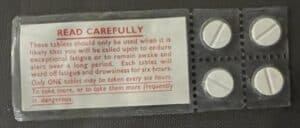A 2.5 inch by 4 inch blister pack of 4 Alertness tablets, issued to Canadian soldiers in WWII.
The “Line” drugs are believed to be manufactured by Smith, Kline, and French in the UK. As a performance war in reaction to the German drug enhancement program of World War II.
As early as 1919, Akira Ogata synthesized methamphetamine via reduction of ephedrine using red phosphorus and iodine. Later, the chemists Hauschild and Dobke from the German pharmaceutical company Temmler developed an easier method for converting ephedrine to methamphetamine. As a result, it was possible for Temmler to market it on a large scale as a nonprescription drug under the trade name Pervitin (methamphetamine hydrochloride). Pervitin was commonly used by the German and Finnish militaries. Adolf Hitler is rumored to have begun using amphetamine occasionally after 1937, and to have become addicted to it in late 1942; although this is disputed by historians who argue he was suffering from health issues.
It was widely distributed across German military ranks and divisions, from elite forces to tank crews and aircraft personnel, with millions of tablets being distributed for its stimulant effects and to induce extended wakefulness.
More than 35 million three-milligram doses of Pervitin were manufactured for the German army and air force between April and July 1940; however, this amounts to only three tablets per serviceman a month. Use of Pervitin was restricted by the Wehrmacht and Nazi Germany as a whole under the Opium Law, which required the drug be obtained through a physician’s prescription.
After April 1941 the drug was no longer distributed to servicemen on a mass scale due to its dangerous side effects, and several deaths were attributed to Pervitin. Use continued albeit closely monitored. In the military, Pervitin was discouraged during combat due to its negative side effects, it was more commonly abused behind the front lines.
Despite the new controls, authorities observed that Pervitin consumption rose rapidly, and so did civilian production, from about seven and a half million tablets in 1941, to nine million tablets in 1942 and a similar amount the following year, to eight million tablets in 1944. As a rule, military production was about half of civilian production. These numbers can be misleading as Nazi Germany had a population of over 80 million during the war, individuals acquired only small numbers of doses at a time and were required to report usage to the authorities.
In Japan, methamphetamine was sold under the registered trademark of Philopon by Dainippon Pharmaceuticals (present-day Dainippon Sumitomo Pharma [DSP]) for civilian and military use. It has been estimated that one billion Philopon pills were produced between 1939 and 1945. As with the rest of the world at the time, the side effects of methamphetamine were not well studied, and regulation was not seen as necessary. In the 1940s and 1950s, the drug was widely administered to Japanese industrial workers to increase their productivity. In Finland, Pervitin was colloquially known as höökipulveri (“pep powder”). Its use was essentially restricted to special forces, especially to long-range commandos.
Amphetamine was also given to Allied bomber pilots during World War II to sustain them by fighting off fatigue and enhancing focus during long flights. During the Persian Gulf War, amphetamine became the drug of choice for American bomber pilots, being used on a voluntary basis by roughly half of U.S. Air Force pilots. The Tarnak Farm incident during the War in Afghanistan (2001-21), in which an American F-16 pilot killed several friendly Canadian soldiers on the ground, was blamed by the pilot on his use of amphetamine. A nonjudicial (UCMJ Article 15) U.S. Air Force hearing rejected the pilot’s claim.
Due to amphetamines addiction liability in some people, newer wakefulness-promoting drugs such as modafinil have been seen as possible safer alternatives for military use in some countries, including the United States.

